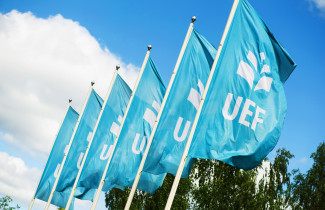Wood has been used in outdoor building since times earlier than the Stone Age and remains a topic material for terraces, fences, house frames and surfaces, possibly more so today than ever due to its renewable nature and functionality as a carbon sink. During its lifetime, wood gets decayed by many different factors, but in Finland and most of European countries, fungi are the most often responsible of the structural and visual degradation of wood. Due to it, chemical treatments to preserve wood are necessary to extend material service lifespan and keep the buildings in good condition, as well as reduce the amount of wood required to substitute decayed wood. Additionally, new bio-based chemicals, extracted from industrial side-streams and residues, could substitute some of those chemicals that are most harmful in the present preservative formulations. Many studies have focused in finding bio-based preservatives to protect wood, but few of them have tested their ecotoxicity and still less have been used by the wood industry.
The aim of this doctoral thesis was to study the possibility of using the bio-based side-streams and residues from wood and coffee industries in Finland for wood preservative formulations. The work further develops the knowledge base on the possibility of using bio-based chemicals to preserve wood. It also elaborates on the possibility of chemical recovery from unused side-streams and material residues, and on the ecotoxicity of these bio-based compounds compared to the ones used traditionally by the wood industry.
The results of the thesis showed that the extracts from spent coffee and silverskin, as well as the pyrolysis distillates of European aspen, Norway spruce and Silver birch bark had antifungal properties against the wood-decaying fungi in petri dish test. The antifungal activity of the distillates was higher than that of the spent coffee and silverskin extracts. This activity of the studied distillates and extracts was not only caused by one of their constituents, but by several of them. Several organic acids were related to the antifungal activity of the pyrolysis distillates of bark, while caffeine, organic acids and their derivatives played a very important role in spent coffee and silverskin extracts. It is relevant to highlight that caffeine and propionic acid had a very high antifungal performance, like that of some commercial wood preservatives. When wood was impregnated with these bio-based antifungals to test the chemical leaching and the wood decay performance, the antifungals leached easily from wood and did not protect wood from fungal decay. Thus, these extracts and distillates cannot be used as wood preservatives as such, but they contain antifungal agents that could be used in wood preservative formulations. Therefore, this study demonstrated that spent coffee, silverskin and bark have biorefining potential to yield bioactive chemicals for wood preservative formulations.
The doctoral dissertation of MSc Aitor Barbero López in Wood Materials Science, entitled Recovery of antifungal compounds from wood and coffee industry side-streams and residues for wood preservative formulations, will be examined at the Faculty of Science and Forestry on 9 December 2020. The opponent in the public examination will be PD Dr. habil. Christian Brischke, University of Göttingen, Germany, and the custos will be Associate Professor Antti Haapala, University of Eastern Finland. The public examination will be held in English.



